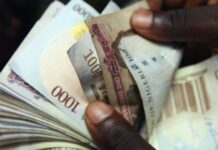Grace Cofie
The deficit spending of the Federal Government has increased to N6.43 trillion from N5.53 trillion. This represented a 51 per cent increase, year-on-year, in seven months to July 2021.
The increase, which is now 16 per cent, was driven by non-discretionary spending on security and C0VID-19 mitigation measures.
The Public Finance analysis of data on the federal government’s fiscal activities showed that revenue rose to N2.45 trillion indicating a 13 per cent increase in the corresponding period of seven months.
Explaining the factors driving the federal government’s deficit spending, which rose in June and July, the CBN, in its Monthly Economic Report for July 2021, said: “The impact of improved revenue out-turn in July 2021 was weakened by 8.9 per cent growth in expenditure, triggering an expansion of the fiscal deficit.
“Payoffs from expenditure rationalisation and revenue mobilisation efforts appeared subdued by new and rising non-discretionary spending, particularly on security and COVID-19 mitigation measures.
“Consequently, the provisional fiscal deficits of the FGN, at N699.48 billion, exceeded the position in June 2021 and the budget benchmark by 1.6 per cent and 49.8 per cent, respectively.
“Growth in FGN retained revenue was owing to the 60.4 per cent rise in receipt from the Federation Account. Retained revenue of the Federal Government increased by 24.9 per cent to N394.11 billion, relative to June 2021.
“Nonetheless, FGN receipts in July 2021 fell below the benchmark of N665.53 billion by 40.8 per cent, suggesting the prevalence of revenue challenge in the review period.
“Provisional aggregate expenditure of the FGN, at N1.093 trillion, rose by 8.9 per cent, relative to June 2021, but remained below the 2021 proportionate benchmark of N1,132.34 billion by 3.4 per cent.
“The increase was due to a 5.9 per cent rise in recurrent expenditure. Disaggregation of the expenditure reveals the dominance of recurrent spending, constituting 88.6 per cent of total government expenditure in July 2021, while capital expenditure and transfers accounted for the balance of 7.6 per cent and 3.8 per cent, respectively.
“Compared with the projected expenditure composition of 61.9 per cent (recurrent expenditure), 28.3 per cent (capital expenditure), and 6.7 per cent (transfers), the largely disproportionate share of recurrent expenditure in July 2021 is indicative of lags in capital releases.”
The International Monetary Fund (IMF) and Fitch Ratings have projected the figure to increase by the end of the year.
Fitch Ratings, in a report titled, “Nigeria Country Risk Report”, which was released last week said, “We have revised our forecast for Nigeria’s budget deficit to 4.8% of GDP in 2021 from our earlier forecast of 4.2%. The revision reflects fiscal data – published by the Nigerian Treasury in October and covering the period January-August 2021 – indicating weaker revenue collection than we had previously anticipated.
“The shortfall was largely due to significant underperformance by the oil sector (45.6% of revenue in 2020), which saw oil revenue come in 43.7% below official revenue projections contained in the government’s 2021 budget, largely as a result of weak oil production.
“While we expect both oil and non-oil revenue to rise in the final months of 2021 as oil production increases and economic growth gathers momentum, this will be insufficient to offset prior underperformance, and we expect federal government revenue to come in at a weak 1.6% of GDP (NGN4.0tn) over 2021, compared with NGN3.9tn in 2020.”
The IMF, while projecting an increase of the nation’s fiscal deficit-to-GDP ratio to 6.3 per cent in 2022, has called for reforms, including removal of the fuel and electricity subsidies, as a way of combating the rising fiscal deficit of the FG.
In its 2021 Article IV Staff mission to Nigeria, the IMF stated that “Despite much higher oil prices, the general government fiscal deficit is projected to widen in 2021 to 6.3 percent of GDP, reflecting implicit fuel subsidies and higher security spending, and remain at that level in 2022.
“There are significant downside risks to the near-term fiscal outlook from the ongoing pandemic, weak security situation and spending pressures associated with the electoral cycle. Over the medium term, without bold revenue mobilization efforts, fiscal deficits are projected to stay elevated above the pre-pandemic levels with public debt increasing to 43 percent in 2026.
“General government interest payments are expected to remain high as a share of revenues making the fiscal position highly vulnerable to real interest rate shocks and dependent on central bank financing.”
The World Bank, in its latest Nigeria Development Report has supported the IMF and its call for reforms.
It read, “Due to deteriorating revenues, our forecast for the consolidated government fiscal deficit has been revised upward. Nigeria’s fiscal deficit is now projected to reach 5.7 percent of GDP by end-2021, its highest level in over a decade.
“Despite rebounding oil prices, Nigeria’s oil output has fallen, and total fiscal revenues are expected to recover only modestly from 6.5 percent of GDP in 2020 to 7.1 percent in 2021, well below their 2014 level of 11 percent.
“Faced with a widening budget deficit, policymakers have increasingly turned to costly Central Bank of Nigeria, CBN, overdrafts (also known as Ways and Means financing), which are not properly integrated into the fiscal accounts. The high cost of servicing CBN overdrafts is compounded by large off budget expenditures—especially the Petrol Motor Spirit, PMS, subsidy—which crowd out much-needed investments in human and physical capital. While Nigeria’s debt burden remains manageable for the time being, maintaining sustainable debt dynamics will require curbing the use of CBN financing for the deficit and addressing fiscal pressures to break the cycle of low growth and rising public debt.”











